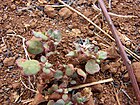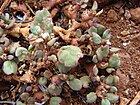Note: This is a project under development. The articles on this wiki are just being initiated and broadly incomplete. You can Help creating new pages.
Trianthema portulacastrum
Horse purslane is an annual, succulent, prostrate or ascending herb, often much-branched, growing up to about 60 cm tall, with a firm taproot. The plant is harvested from the wild for local use. It has a number of medicinal virtues and is sometimes also eaten, though there are conflicting reports on the wisdom of this. The dried plants are sometimes traded for their medicinal qualities.
Contents
- 1 Uses
- 2 Parts Used
- 3 Chemical Composition
- 4 Common names
- 5 Properties
- 6 Habit
- 7 Identification
- 8 List of Ayurvedic medicine in which the herb is used
- 9 Where to get the saplings
- 10 Mode of Propagation
- 11 How to plant/cultivate
- 12 Commonly seen growing in areas
- 13 Photo Gallery
- 14 References
- 15 External Links
Uses
Asthma, Amenorrhoea, Venereal discharge, Oedema, Jaundice, Strangury, Dropsy, Gonorrhoea, Rheumatism, [[:Category:Ayurvedic Herbs known to be helpful to treat |]], [[:Category:Ayurvedic Herbs known to be helpful to treat |]].[1]
Parts Used
Chemical Composition
Common names
| Language | Common name |
|---|---|
| Kannada | Muchchugoni, Bili komme |
| Hindi | Sabuni, Salsabuni |
| Malayalam | Talutama |
| Tamil | Sharunnai, Shavalai |
| Telugu | Ambatimadu, Galijeru |
| Marathi | Pundhari-ghentuli |
| Gujarathi | |
| Punjabi | |
| Kashmiri | |
| Sanskrit | Chiratika, Dhanapatra |
| English | Desert Horse Purslane, Giant pigweed |
Properties
Reference: Dravya - Substance, Rasa - Taste, Guna - Qualities, Veerya - Potency, Vipaka - Post-digesion effect, Karma - Pharmacological activity, Prabhava - Therepeutics.
Dravya
Rasa
Guna
Veerya
Vipaka
Karma
Prabhava
Habit
Identification
Leaf
| Kind | Shape | Feature |
|---|---|---|
Flower
| Type | Size | Color and composition | Stamen | More information |
|---|---|---|---|---|
| {{{5}}} |
Fruit
| Type | Size | Mass | Appearance | Seeds | More information |
|---|---|---|---|---|---|
Other features
List of Ayurvedic medicine in which the herb is used
Where to get the saplings
Mode of Propagation
How to plant/cultivate
The plant has escaped from cultivation and become an aggressive weed in many parts of the tropics.[5]
Commonly seen growing in areas
Wastelands, Roadsides, Roadsides, Cultivated crops, Paddy fields.
Photo Gallery
References
- ↑ Indian Medicinal Plants by C.P.Khare
- ↑ [Chemical constituents]
- ↑ Common names
- ↑ [Morphology]
- ↑ Cultivation
External Links
- Ayurvedic Herbs known to be helpful to treat Asthma
- Ayurvedic Herbs known to be helpful to treat Amenorrhoea
- Ayurvedic Herbs known to be helpful to treat Venereal discharge
- Ayurvedic Herbs known to be helpful to treat Oedema
- Ayurvedic Herbs known to be helpful to treat Jaundice
- Ayurvedic Herbs known to be helpful to treat Strangury
- Ayurvedic Herbs known to be helpful to treat Dropsy
- Ayurvedic Herbs known to be helpful to treat Gonorrhoea
- Ayurvedic Herbs known to be helpful to treat Rheumatism
- Ayurvedic Herbs known to be helpful to treat
- Herbs with Leaves used in medicine
- Herbs with common name in Kannada
- Herbs with common name in Hindi
- Herbs with common name in Malayalam
- Herbs with common name in Tamil
- Herbs with common name in Telugu
- Herbs with common name in Marathi
- Herbs with common name in Sanskrit
- Herbs with common name in English
- Habit - Annual
- Index of Plants which can be propagated by Seeds
- Herbs that are commonly seen in the region of Wastelands
- Herbs that are commonly seen in the region of Roadsides
- Herbs that are commonly seen in the region of Cultivated crops
- Herbs that are commonly seen in the region of Paddy fields
- Herbs









